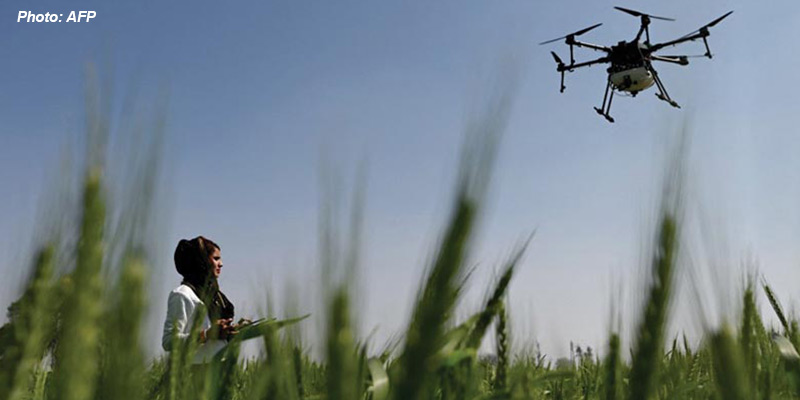- India
- Nov 04
- Sreesha V.M
How frontier technologies can transform agricultural landscape?
• NITI Aayog’s Frontier Tech Hub unveiled a roadmap titled ‘Reimagining Agriculture: A Roadmap for Frontier Technology Led Transformation’ on November 3.
• The roadmap outlines a strategic vision to harness frontier technologies, including climate resilient seeds, digital twins, precision agriculture, agentic AI, and advanced mechanisation to enhance productivity, sustainability, and incomes across India’s diverse agricultural landscape.
• By segmenting farmers into three primary archetypes — Aspiring, Transitioning, and Advanced — the roadmap offers tailored, actionable solutions sensitive to the varied challenges faced by smallholders to commercial cultivators.
• The roadmap highlights that with the right interventions, India can unlock new levels of agricultural resilience, inclusive rural prosperity, and global competitiveness in agri-tech innovation, contributing meaningfully towards the vision of Viksit Bharat by 2047.
• The real impact of frontier technologies will come from how well we customise solutions — whether for a smallholder or a commercial cultivator; a farmer growing staples or a horticulturist.
Why a paradigm shift is needed?
• Over 86 per cent of Indian farmers are smallholders, with an average landholding size of 0.74 hectares.
• Employing 45.8 per cent of the national workforce and producing nearly one billion tonnes of food annually, the sector underpins employment generation, national health outcomes, and inclusive economic growth.
• For India to achieve the status of a developed nation by 2047, its per capita Gross National Income (GNI) must rise five-fold, a goal inseparable from achieving a commensurate increase in agrarian incomes and productivity.
• Reliance on resource-intensive practices, compounded by limited irrigation and mechanisation, exacerbates the farmers’ vulnerability to extreme weather shocks, rapid soil degradation and groundwater depletion.
• Substantial post-harvest losses, exceeding $18 billion in 2022 alone, inequitable value chains, and asymmetric bargaining power further depress farmer incomes.
• Further, systemic gaps in access to finance, insurance buffers, and entrenched digital divides leave millions of farmers unable to benefit from existing solutions.
• To unlock the next economic leap for the country and boost farmer incomes, a paradigm shift is needed.
• Structural reforms, last-mile enablement, and deep technological innovations will be critical to improving agricultural productivity, minimising post-harvest losses, accelerating the export footprint, and increasing the sustainability and climate resilience of food systems.
The critical role of frontier technologies in agriculture
• While fertilizers, genetically modified crops, and biotechnology have brought substantial benefits for farmers in recent decades, the accelerated application of smart, digital, and precision agricultural technologies offers a historic opportunity to improve farm productivity going forward.
• Such technologies are wide-ranging, including small mobile applications for decision support, field sensors and remote sensing technologies for data collection, drones and robots for automation of processes, and digital platforms for market access and sales.
• Use of these technologies helps address information asymmetries and deficiencies facing farmers, particularly smallholders, which can improve agricultural productivity and save costs, while also helping to mitigate the environmental impact of farm activities.
• The application of smart, digital, and precision technologies has already had a significant impact on farming worldwide.
• Smallholder farmers face challenges throughout the agricultural cycle, from crop planning and purchase of inputs to harvesting, processing, and sale of their products.
• Many of these challenges stem from insufficient information.
• Throughout the agricultural cycle, smallholder farmers also face particular challenges in accessing information about weather and climate, knowledge on plot-specific inputs and planting techniques, and data about markets, which would allow them to establish stronger and more direct links to consumers.
• Frontier technologies can play a role in mitigating these information asymmetries by providing real-time and precise data that inform smallholder farmers in their decision-making at every stage of the agricultural cycle.
• Initiatives like the Digital Agricultural Mission, National Mission on Agriculture & Technology, Kisan Drone Scheme, and National Mission for Sustainable Agriculture have made strides in enhancing agricultural outcomes and improving the on-farm effectiveness of technologies in India.
• Achieving sustained, inclusive transformation requires accelerating the integration and scaling of frontier technologies, bridging current implementation gaps, and fostering an enabling environment for continuous innovation.
• Frontier technologies, in the context of Indian agriculture, need to be tailored to account for the heterogeneity of the country’s farmers.
• From rain-fed, subsistence smallholders to progressive, commercial-grade cultivators, each farmer faces a unique set of challenges and seeks curated solutions.
• India’s next agricultural leap will be powered by frontier technologies. Concerted efforts through the Digital Agriculture Mission have laid strong groundwork for a modern agricultural ecosystem.
• Yet, as agricultural practices and technologies advance rapidly, the system must evolve into its next iteration and overcome the system roadblocks.
• Beyond food systems, India’s agriculture holds the promise of becoming a powerful engine of economic growth with a rapidly advancing bioeconomy sector, projected to reach $300 billion by 2030.
• The pace of disruption demands bold thinking and novel instruments. Frontier technologies, spanning digital, biological, mechanical, and material science innovations, are redefining what is possible in farming and enabling a new era of agricultural transformation.
• These innovations offer pathways for mitigation, resilience, and adaptation, and can position India as a global leader and partner of choice in agricultural innovation.
(The author is a trainer for Civil Services aspirants.)

